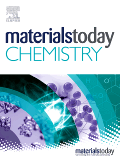
Materials Today Chemistry
Scope & Guideline
Exploring Breakthroughs in Material Applications
Introduction
Aims and Scopes
- Advanced Materials Synthesis and Characterization:
Research dedicated to the synthesis of new materials, including nanostructured and composite materials, with a focus on their structural, optical, and electronic properties. - Photocatalysis and Energy Conversion:
Studies involving materials designed for photocatalytic applications, including CO2 reduction and hydrogen production, emphasizing sustainable energy solutions. - Biomaterials and Biomedical Applications:
Research on materials designed for medical applications, including drug delivery systems, wound healing, and tissue engineering, focusing on biocompatibility and functionality. - Environmental Remediation:
Development of materials aimed at addressing environmental challenges, such as wastewater treatment and pollutant degradation, often utilizing advanced photocatalytic and adsorptive properties. - Smart and Responsive Materials:
Exploration of materials that respond to external stimuli, including temperature, pH, and light, for applications in sensors and drug delivery systems. - Electrocatalysis and Energy Storage:
Innovative materials for electrocatalytic processes, particularly in fuel cells and batteries, focusing on enhancing efficiency and stability.
Trending and Emerging
- Sustainable and Green Materials:
An increasing emphasis on the development of sustainable materials, including biodegradable polymers and eco-friendly synthesis methods, aligns with global sustainability goals. - 2D Materials and Nanotechnology:
There is a significant trend towards research involving two-dimensional materials, such as MXenes and graphene, due to their unique properties and potential applications in electronics and energy storage. - Machine Learning and AI in Materials Science:
The integration of machine learning and artificial intelligence techniques in materials design and discovery is emerging as a key area, enhancing predictive capabilities and efficiency. - Hybrid and Composite Materials:
Research on hybrid materials that combine different functionalities, such as magnetic and conductive properties, is gaining traction, particularly for applications in energy storage and conversion. - Smart and Stimuli-Responsive Systems:
There is a growing interest in materials that respond dynamically to environmental stimuli, which are increasingly being explored for applications in drug delivery and sensors. - Electrocatalysis for Renewable Energy:
Research focused on electrocatalytic materials for energy conversion processes, such as CO2 reduction and hydrogen evolution, is on the rise, driven by the need for sustainable energy solutions.
Declining or Waning
- Traditional Semiconductor Research:
There has been a decrease in studies focused on conventional semiconductor materials, as research has shifted towards more innovative materials like 2D materials and organic semiconductors. - Bulk Material Properties:
Research on the bulk properties of traditional materials is declining in favor of studies that focus on nanostructured or composite materials with enhanced functionalities. - Single-Use Polymers:
The focus on single-use plastics and related materials has diminished, reflecting a broader societal shift towards sustainability and the development of biodegradable alternatives.
Similar Journals

ADVANCED FUNCTIONAL MATERIALS
Fostering Collaboration in Electronic, Optical, and Magnetic MaterialsADVANCED FUNCTIONAL MATERIALS is a leading journal published by WILEY-V C H VERLAG GMBH, prominently recognized in the fields of biomaterials, chemistry, condensed matter physics, and materials science. With an impressive impact factor and a distinguished position in the Q1 quartile across multiple categories including nanoscience and nanotechnology, this journal serves as a vital platform for researchers and professionals committed to innovating in functional materials. Since its inception in 2000, ADVANCED FUNCTIONAL MATERIALS has published high-quality peer-reviewed articles that push the boundaries of materials science, exploring new frontiers in electronic, optical, and magnetic materials. The journal's dedication to open access ensures that its groundbreaking findings are readily available to a global audience, fostering collaboration and knowledge-sharing among scholars and practitioners in the field. For those seeking to stay at the forefront of materials research, ADVANCED FUNCTIONAL MATERIALS is an essential resource.

Journal of Nanostructures
Empowering Researchers to Explore NanomaterialsJournal of Nanostructures, published by UNIV KASHAN PRESS, is an esteemed open-access journal that has been actively disseminating groundbreaking research since 2011. With an ISSN of 2251-7871 and an E-ISSN of 2251-788X, this journal has established itself as a significant platform for the exploration of nanostructured materials across various disciplines, including biomaterials, electronic, optical, and magnetic materials. As a testament to its scholarly impact, the journal has achieved notable rankings in its respective categories, including Q3 status in prominent areas such as Mechanics of Materials and Polymers and Plastics. This makes the Journal of Nanostructures a vital resource for researchers and professionals seeking to advance their understanding and innovation in nanotechnology. Furthermore, the journal's commitment to open accessibility ensures that valuable knowledge reaches a diverse audience, facilitating collaboration and growth in this dynamic field. For researchers eager to contribute, the journal offers a platform to publish impactful findings that can influence both academia and industry.
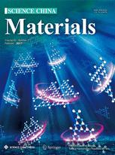
Science China-Materials
Leading the Charge in Materials Research Excellence.Science China-Materials is an esteemed peer-reviewed journal dedicated to advancing the field of materials science, published by SCIENCE PRESS. With a strong focus on innovative research and applications, this journal provides an essential platform for disseminating groundbreaking findings in materials development, characterization, and engineering. Since its inception, Science China-Materials has achieved an impressive Q1 ranking in the Materials Science (miscellaneous) category, reflecting its commitment to quality and the impact of its publications, as indicated by its 86th percentile ranking in Scopus. The journal is set to converge its contributions from 2016 to 2024, making it a vital resource for researchers and professionals interested in the latest advancements and trends in materials science. As an open access publication, it ensures that knowledge is freely available to a global audience, promoting collaboration and innovation across disciplines. The journal is headquartered in Beijing, China, and continues to attract high-quality submissions from leading experts in the field.

Materials Chemistry Frontiers
Elevating Knowledge in the World of Materials ChemistryMaterials Chemistry Frontiers, published by the esteemed Royal Society of Chemistry, stands as a leading journal in the realm of materials science and chemistry, with an impressive Q1 ranking in both Materials Chemistry and Materials Science categories as of 2023. This open-access journal, operating from the United Kingdom, offers a platform for researchers, professionals, and students to disseminate high-quality, impactful research. With its E-ISSN 2052-1537, the journal is dedicated to publishing cutting-edge articles, reviews, and research communications that explore innovative materials and their applications, fostering a comprehensive understanding of the complex interplay between materials and their chemical properties. With consistent rankings in the Scopus metrics, being positioned at the 25th percentile among 317 in the Materials Chemistry category, it highlights its pivotal role in advancing the field. The journal thrives on contributions that broaden the scope of knowledge from 2017 to 2024 and beyond, solidifying its status as an essential resource for contemporary research in materials science.
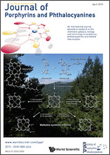
JOURNAL OF PORPHYRINS AND PHTHALOCYANINES
Exploring the Frontiers of Porphyrins and PhthalocyaninesJOURNAL OF PORPHYRINS AND PHTHALOCYANINES, published by WORLD SCIENTIFIC PUBL CO PTE LTD, is an influential peer-reviewed journal dedicated to advancing the field of porphyrins and phthalocyanines, key compounds in both chemistry and materials science. With an ISSN of 1088-4246 and an E-ISSN of 1099-1409, this journal has been a vital resource since its inception in 1997 and is expected to continue until 2024. The journal holds a respectable position in the academic landscape, categorized in the Q3 quartile for miscellaneous Chemistry journals and ranked #252 out of 408 in the general chemistry category according to Scopus, reflecting a growing impact in the field despite its current percentile standing at 38th. JOURNAL OF PORPHYRINS AND PHTHALOCYANINES seeks to publish original research articles, reviews, and critical studies that explore the synthesis, characterization, and applications of these versatile compounds, which play essential roles in numerous scientific disciplines, from catalysis to materials development. This journal is an indispensable platform for researchers and professionals seeking to disseminate their findings, engage with contemporary discussions, and stay informed about cutting-edge advancements in porphyrin and phthalocyanine research.

Small Science
Exploring Innovations in Chemical Engineering and BeyondSmall Science is an esteemed open-access journal published by WILEY, dedicated to pioneering research in the realms of catalysis, materials science, and chemical engineering. Established in 2021, this journal has rapidly gained recognition, ranking in the top quartiles (Q1) in various categories, including a remarkable 17th position in Materials Science and 8th in Chemical Engineering on Scopus. With an impact factor reflective of its growing influence and a commitment to disseminating cutting-edge knowledge, Small Science serves as a crucial platform for researchers, professionals, and students seeking to explore the latest advancements and applications in these dynamic fields. The journal's open-access model ensures wide reach and accessibility, facilitating collaboration and innovation across disciplines. Its headquarters are located in the United States, at 111 River St, Hoboken, NJ, supporting a global readership keen on addressing contemporary scientific challenges and driving progress in technology and materials synthesis.

Polymer-Plastics Technology and Materials
Championing Open Access in Material AdvancementsPolymer-Plastics Technology and Materials is a premier academic journal published by Taylor & Francis Inc., dedicated to the dynamic fields of chemical engineering, materials chemistry, and polymers and plastics. With an impact factor that reinforces its reputation, this journal is strategically indexed in Scopus, ranked notably within its categories (Q2), showcasing its influence and relevance in the academic community. Since its inception in 2019, the journal has served as an essential platform for researchers, professionals, and students to disseminate innovative studies and advancements in polymer science and materials technology. As an Open Access publication, it ensures that cutting-edge research is accessible to a global audience, fostering collaboration and knowledge sharing in the material sciences. Located in the United Kingdom, Polymer-Plastics Technology and Materials continues to enhance the dialogue within the industry, addressing critical challenges and exploring emerging trends that shape the future of polymer and plastics technologies.

Materials Futures
Pioneering insights in biomaterials for a sustainable tomorrow.Materials Futures, an esteemed journal published by IOP Publishing Ltd, stands out as a pivotal resource in the field of Materials Science, with a particular emphasis on Biomaterials. Launched in 2022 and operating under an Open Access model, the journal aims to foster accessibility and rapid dissemination of pioneering research, thus catering to the diverse needs of researchers, professionals, and students globally. With a commendable Scopus Rank of #46 out of 137 in its category, placing it in the 66th percentile, and recognized as a Q1 journal as of 2023, Materials Futures provides a vital platform for cutting-edge studies and innovations that address contemporary challenges in materials science. As the journal evolves through its convergence period from 2022 to 2024, it continues to attract high-quality submissions aimed at advancing knowledge and applications within the biomaterials sector, reflecting its commitment to contributing vital insights and fostering collaboration across disciplines. Explore Materials Futures for your research endeavors and join a community dedicated to shaping the future of materials.
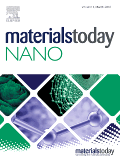
Materials Today Nano
Empowering Knowledge in Nano-Materials for Global ImpactMaterials Today Nano, published by Elsevier, is a premier academic journal dedicated to the forefront of nano-materials research, encompassing innovations and advancements in biomaterials, condensed matter physics, electronic, optical, and magnetic materials, as well as materials chemistry. With an impressive Q1 ranking across multiple categories, including biomaterials and materials chemistry, this journal serves as a essential platform for researchers, professionals, and students aiming to contribute to and stay informed on cutting-edge developments that push the boundaries of materials science. Its open access model allows for wider dissemination of high-impact findings, ensuring that the research reaches a global audience. Operating from the United Kingdom, Materials Today Nano plays a vital role in fostering interdisciplinary collaboration and advancing scientific understanding in this rapidly evolving field.
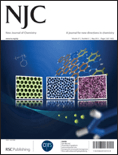
NEW JOURNAL OF CHEMISTRY
Innovating Research, Catalyzing ChangeNEW JOURNAL OF CHEMISTRY, published by the prestigious Royal Society of Chemistry, serves as a vital platform for the dissemination of research in the dynamic fields of chemistry, catalysis, and materials science. With an impressive ISSN of 1144-0546, this journal boasts a rich history, having been established in 1996, and is set to continue its impactful publication through 2024. The journal is recognized in several categories, achieving a Q2 ranking in both chemistry and materials chemistry, and a Q3 rank in catalysis, reflecting its significance within these disciplines. Researchers will find it particularly noteworthy that the journal holds an esteemed position in the Scopus rankings, with a 65th percentile standing in general chemistry. Though it currently operates on a subscription model, its commitment to advancing the frontiers of chemistry makes it an essential resource for academics, professionals, and students seeking to keep abreast of the latest advancements and innovative methodologies in their fields.